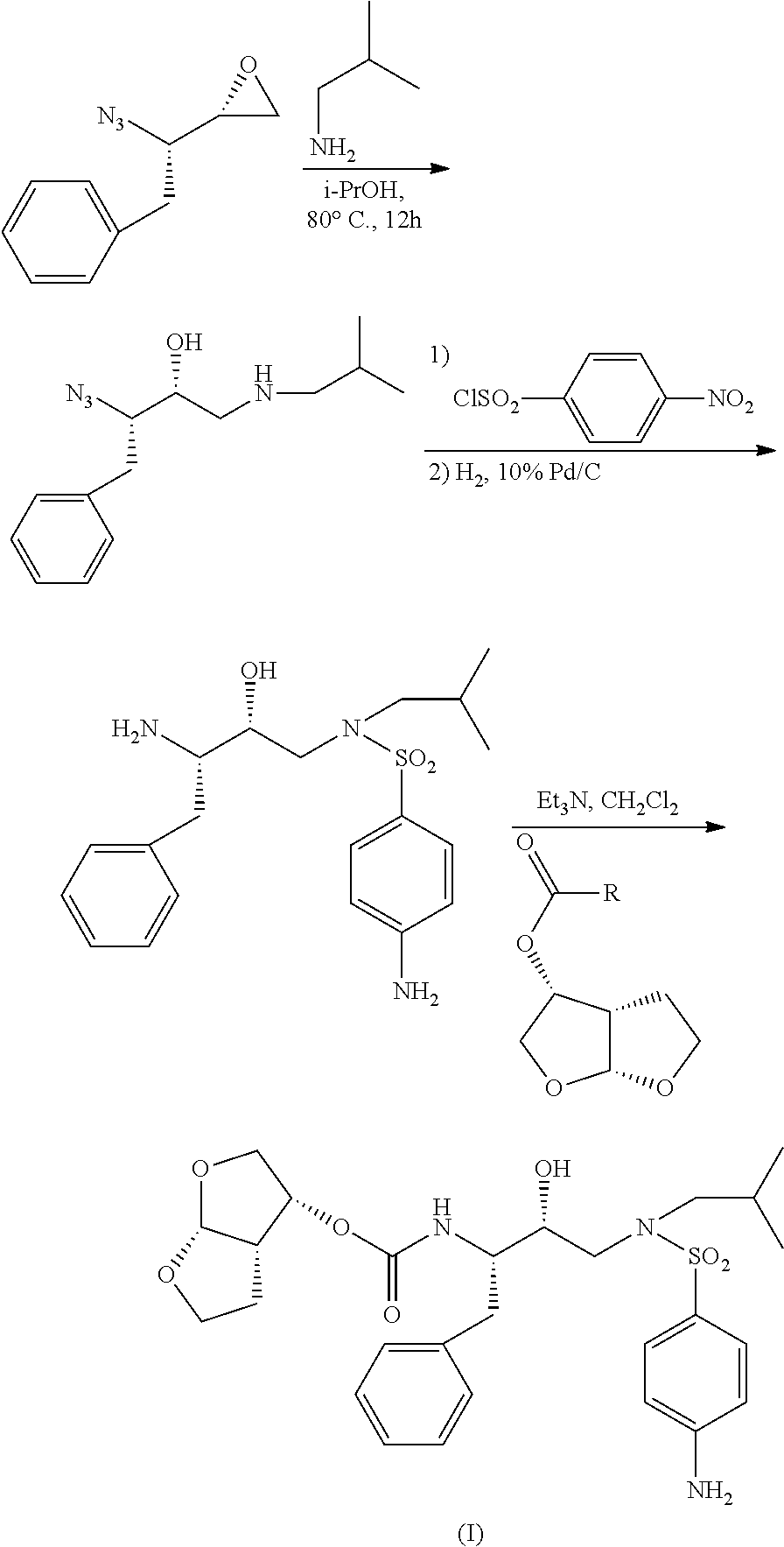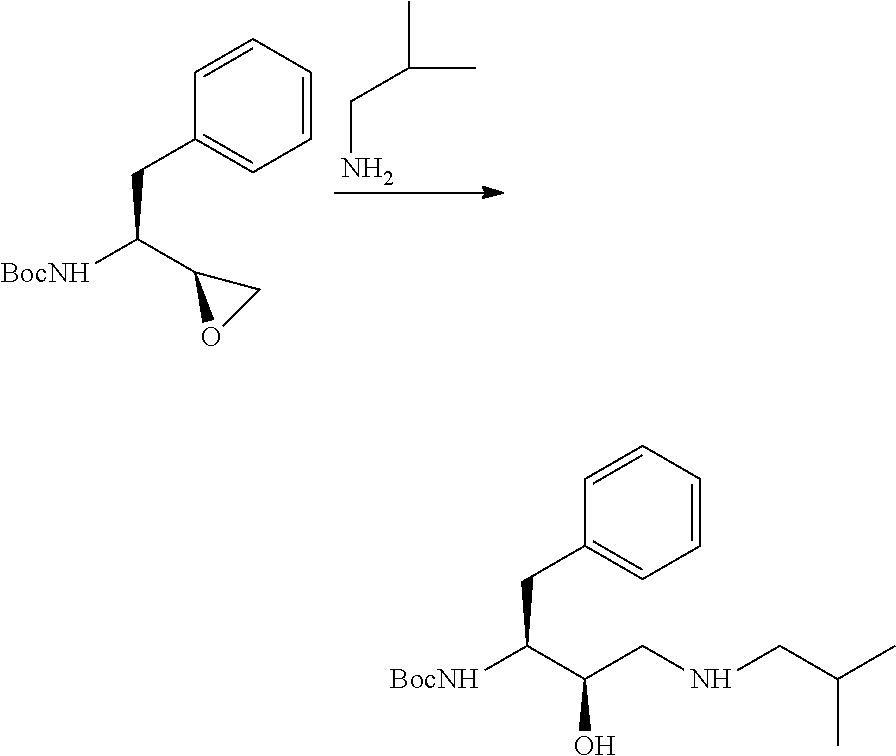Process for the preparation of darunavir and darunavir intermediates
- Summary
- Abstract
- Description
- Claims
- Application Information
AI Technical Summary
Benefits of technology
Problems solved by technology
Method used
Image
Examples
example 1a
Preparation of (3R,3aS,6aR)-hexahydrofuro[2,3-b]furan-3-yl-N-[(1S,2R)-3-chloro-1-benzyl-2-hydroxypropyl]carbamate (Compound IV)
[0123]1,1′-carbonyldiimidazole (162.15 g, 1 mol) was added to THF (0.5 L), following by solution of (3R,3aS,6aR)-hexahydrofuro[2,3-b]furan-3-ol (135.2 g, 1.04 mol) in 0.3 L of THF and the mixture was stirred for a further hour. (2S,3S)-3-amino-1-chloro-2-hydroxy-4-phenylbutane hydrochloride (229 g, 0.97 mol) was added and the mixture heated at 55-60° C. approximately 5-6 hours under TLC control (for complete disappearance of (2S,3S)-3-amino-1-chloro-2-hydroxy-4-phenylbutane). After completion of reaction the solution was cooled and transformed to the next step. For the preparation of analytical sample, 10 ml of solution was diluted with 50 ml of ethyl acetate, washed with water (40 mL), diluted hydrochloric acid (40 ml), 5% aqueous sodium hydrogen carbonate (40 mL) and water (50 mL). The solution was dried over sodium sulfate and evaporated to dryness. MS: m...
example 1b
Preparation of (3R,3aS,6aR)-hexahydrofuro[2,3-b]furan-3-yl-N-[(1S,2R)-3-chloro-1-benzyl-2-hydroxypropyl]carbamate (Compound IV)
[0124]1. (3R,3aS,6aR)-hexahydrofuro[2,3-b]furan-3-ol (100 mg) was added into a pre-dried 25 ml round bottom flask under nitrogen. Disuccinimidyl carbonate (DSC) (295 mg) was then added followed by acetonitrile (3 ml). Et3N (155 mg) was added while stirring, until the suspension became clear. The resulting solution was stirred at ambient temperature for 5 hours under TLC control. The solvent was then removed, saturated solution of NaHCO3 (4 ml) was added, and extracted with EtOAc (3*20 ml). The combined organic fractions were dried with Na2SO4, filtered, and concentrated to an oily residue. MeOH (4 ml) was added, and the resulting suspension was stirred, then filtered and dried to give 152 mg of compound III as a white solid.[0125]2. Compound III from above (125 mg) was added into a pre-dried 25 ml round bottom flask under nitrogen. (2S,3S)-3-amino-1-chloro-2...
example 2
Preparation of (3R,3aS,6aR)-hexahydrofuro[2,3-b]furan-3-yl-N-[(1S,2R)-3-isobutylamino-1-benzyl-2-hydroxypropyl]carbamate (Compound V)
[0126]1. A mixture from previous step, isobutylamine 73.8 g (1.01 mol) and sodium hydrogen carbonate (92.4, 1.1 mol) in water (1 L) was heated at a gentle reflux (˜60° C.) with stirring until reaction completed under TLC control (˜5 h). Excess isobutyl amine and THF were removed by distillation under nitrogen at an internal reaction temperature of 70-75° C. Additional water (500 g) was added and the product was isolated by filtration, washed with water and dried in vacuum, yielded 360 g (92%) of white to off-white solid, MS: m / z 393 (MH+), 427 [M+Cl]−, NMR spectrum corresponded to structure.[0127]2. Compound IV (100 mg) and isobutylamine (2 ml) were added into a pre-dried 10 ml round bottom flask. The reaction was heated to 60° C. overnight under TLC control. The excess isobutylamine was evaporated and the residue was subjected to column chromatography...
PUM
| Property | Measurement | Unit |
|---|---|---|
| Electrical conductance | aaaaa | aaaaa |
| Electrical conductance | aaaaa | aaaaa |
Abstract
Description
Claims
Application Information
 Login to View More
Login to View More - R&D
- Intellectual Property
- Life Sciences
- Materials
- Tech Scout
- Unparalleled Data Quality
- Higher Quality Content
- 60% Fewer Hallucinations
Browse by: Latest US Patents, China's latest patents, Technical Efficacy Thesaurus, Application Domain, Technology Topic, Popular Technical Reports.
© 2025 PatSnap. All rights reserved.Legal|Privacy policy|Modern Slavery Act Transparency Statement|Sitemap|About US| Contact US: help@patsnap.com



